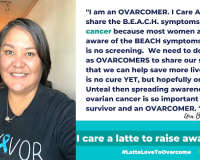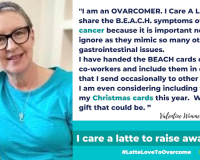Meet, Dipanjan Chowdhury, Ph.D. Dipanjan is the Chief of the Division of Radiation and Genome Stability, at Dana-Farber Cancer Institute and Associate Professor at Harvard Medical School. His Lab has led the research initiative in developing the new blood test to diagnose ovarian cancer. This is a non-invasive diagnostic tool being developed to measure circulating microRNAs to predict ovarian cancer with specificity and accuracy, and to strive towards 0% misdiagnosis. Investigators from Brigham and Women’s Hospital and Dana-Farber Cancer Institute are working on this initiative leveraging the power of artificial intelligence.
Our Founder, Runsi Ayona Sen, discussed the details of this test with Dr. Chowdhury, in a candid conversation. Special thanks to Dr. Chowdhury for taking the time to explain the test in a simplified manner for the benefit of survivor and caregiver community.
Q: Tell us how this AI powered blood test is uniquely different in early detection of ovarian cancer?
A: The first aspect of differentiation, are the molecules – micro RNAs are relatively new class of molecules. They were discovered about 25 years ago, but not much attention was paid to them at that time. The fact that these molecules could be of vital importance to human health and disease really came into the forefront in the last 10-15 years. We have been traditionally focused on other important markers for ovarian cancer including CA125, but haven’t really focused on this class of molecules. Now we are investigating them from all aspects – including how these molecules might impact BRCA gene mutation. As part of our project, we originally started to study them in the tumors themselves, to see how MicroRNAs impact tumors, but as technology developed, we realized we could utilize these class of molecules to have more applications. We started investigating these molecules in blood samples a couple of years ago – which now has emerged as an exciting discovery, potentially medically significant. All current blood tests including CA 125 or derivatives of it, are focused on a different class of molecules. In that sense, this test is unique as it is focused not on those, but on a different class of molecules.
Q: What are the merits of this test vs. the traditional methods in terms of ease, and accuracy?
A: We will have to wait and watch. As far as CA125 being a comparable tool, it has more than 30 years of collectible data. We would need more time to gather additional data in order to make a definitive conclusion on the merits of this blood test. As you know, majority of women with ovarian cancer get diagnosed at an advanced stage, when the survival rate is dramatically lower in comparison to early detection. This test can accurately detect early stage tumors. We used CA125 as our comparative benchmark – one of the major challenges of CA125 test is false discovery or diagnosis of ovarian cancer that might eventually lead to unnecessary removal of ovaries in women. This test from that perspective is almost full proof, in that we might miss a few cancers, but we will not misdiagnose cancer with this test. That’s how we trained the data, with the idea of machine learning via AI.
As a part of this initiative, we conducted Focused Sequencing on 200, and then Validation on 300 patients including a cohort of Polish patients. It was important for us to test these blood samples in relatively obscure places like a small clinic in Poland where the quality of healthcare may not be as gold standard, to test validation and uniformity across platforms. The test worked across all blood samples collected – which is an optimistic result we were hoping for.
Q: Could high-grade as well as low-grade ovarian cancers be detected from this test? What should our survivor community know about this test?
A: Yes, we can detect high grade as well as low grade tumors. The essence of this test is to be able to accurately distinguish between borderline tumors, benign tumors, and malignant tumors.
Q: What are the next steps envisioned in bringing this test from the lab to the clinic?
A: The next major step would be to investigate samples of women prior to their detection of ovarian cancer. We are currently studying two large cohorts – primary cohort is the PLCO (Prostrate Lunch Colorectal & Ovarian Cancer Trial) NIH study involving 78,000 women within the period 1993-2001. We followed them for 13 years, and collected their blood samples. A fraction of these women ended up being diagnosed with ovarian cancer. Their blood samples were collected years prior to them being diagnosed. This study helped us understand the limitations of CA125 and ultrasound tests. Based on the results of our current study, we will be receiving 600 samples from NIH – this will be a blind study, which will effectively be like doing a clinical trial, retrospectively. We would not know which of the samples have ovarian cancer. we will generate the data and send it to them, and they will do the analysis on our algorithm and connect it to their clinical data. Another project in pipeline involves 450 samples from women 1-2-3 years before they were diagnosed with age matched controls, that we will analyze. We have reached a pivotal point in our study where interested partners are ready to give us samples – we need to be prepared to organize and proceed with the project. The fact that we found something that seems exciting and worth following up is what I would call success. We will continue with our efforts to give early detection the significance it deserves. Difference between early detection vs. late is dramatic. It would make a world of difference if we could focus more on early detection and give it as much importance as drug development.
Q: If deployment is successful, could this test be included in annual well-woman visits along with pap-smears and mammograms? Please tell us about the benefits of a test like this for women at high risk for ovarian cancer.
A: Yes, eventually. To bring it to a routine blood test will take time. More immediate benefit can be shown for high risk patients. We are optimistic that we can distinguish between BRCA positive families and be able to say, “even if you are BRCA positive, your risk of having ovarian cancer may not be as high as the next BRCA positive person.” If we are able to monitor a BRCA positive young woman who doesn’t want to get her ovaries removed, via this test, I think it will be a huge win. Immediately though, for us to be able to have a clear idea of who among the BRCA positive family members are more likely to develop ovarian cancer, and monitor them accordingly, would be an example of bringing this test closest to clinic. I certainly hope to see this blood test eventually emerge as a FDA approved routine test, as it has no challenges or issues with toxicity. It is more like if you are more prone to develop cancer, you get this secondary test done, like a scan. Our great first step would be to show that this test is working for the mutation careers.
Q: What would be your message to our community?
A: Early detection of ovarian cancer is critically important. Support initiatives on early detection, stay informed and aware of the signs and symptoms of this disease, and educate others. Together, we can Ovarcome!






